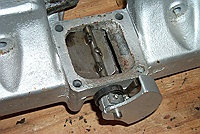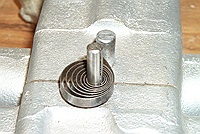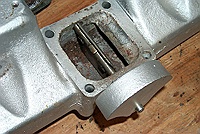|
The heat riser system diverts warm exhaust gases to a chamber inside the intake manifold. When the engine is cold, the valve is held closed by a thermostatically controlled spring. The hot exhaust gases preheat the intake air, enhancing drivability during warm up and cold weather. As the car warms up the thermostatic spring controlled valve opens, reducing the amount of warm air being diverted. At wide open throttle, the valve opens automatically, allowing the exhaust gases to pass straight to the exhaust system. The heat riser is an important part of the fuel system. A riser valve stuck in the open position causes problems such as slow warm up, carburetor icing, stalling and flat spots during acceleration. Another serious problem is the potential for crankcase dilution caused by excessive choke during starting and warm up. A valve frozen in the closed position is just as detrimental. |
Common problems include hard starts when hot, detonation (pinging under load), overheating, burned valves and a warped manifold. Regular maintenance of the heat riser should be on your monthly checklist. With the engine cold, inspect the counterweight, looking for a broken return spring. The unit should easily turn clockwise, then snap back to the upright position when released. If it sticks or is frozen, try carburetor cleaner or Liquid Wrench to loosen up the carbon. Don’t lubricate the shaft with motor oil. It will burn, causing additional carbon buildup. If none of these work, plan on spending a Saturday afternoon to remove, overhaul and reinstall your manifold. Plus you will access to a welder. Before you get started, make sure you have the following parts |
Heat riser repair kit, including shaft,
bushings (2), diverter valve and spring. Some kits include a new
stop, counterweight and spacer. You can use your old parts if these
are missing. Manifold gasket set ( Victor 780 460) Exhaust gasket (Victor 679 023) In addition, you will probably need to replace the nuts and bolts for the exhaust flange (7-16"-20 pitch x 2"), brass nuts for the manifold studs (3/8" x 24 pitch), four bolts (5/16"-18 pitch x 2-1/2") which hold the manifold together. |
Repairs address problems such as a frozen shaft, missing diverter valve, broken thermostatic return spring, or the entire assembly missing! Also, it is common for the gasket to fail between the intake and exhaust manifolds, resulting in an exhaust gas leak. The repair procedure is covered in the service manual but here are a few tips: Before dis-assembly, drain your coolant. When you are removing the manifold nuts it is quite common for the stud to back out of the block. Many are tapped into the water jacket and when they come out your coolant leaks out. After you unscrew all nuts the manifold should slide off with some gentle persuasion. If not, STOP! You have probably missed a nut. The total count is 13 nuts, with one under and behind the heat riser. This one is usually missed. You can, with some difficulty, reach it from above. It is much easier to remove the front passenger wheel to reach the wheel well valve adjustment access panel. Once this panel is removed the nut is within easy reach. In addition, now you can use your torque wrench to properly re-torque everything when you reinstall the manifolds. |
| You may need to loosen all the nuts about a half-inch, then slide the manifold assembly out the half inch before you can remove the nuts. Be sure to use plenty of Liquid Wrench when removing the bolts which hold the exhaust and intake manifold together. My luck has been about fifty-fifty in removing the bolts without breaking. When they do break all is not lost. First, try to carefully drill out the old bolt, then run a tap to clean up the threads. If that fails, use a helicoil kit and install the helicoil per the manufacturer instructions. I have had success using both approaches. When you reassemble the manifolds you might consider using stainless steel bolts. I have found the different metals, along with an anti-seize compound, make it much less likely to freeze together, making future maintenance easier. | Make sure you use the correct length for the bolts. The parts book
calls for 5/16"-18 pitch x 2-1/2". Too long a bolt will not allow
the gasket to seal along the intake and exhaust seam resulting in an
exhaust leak. An overly long bolt may crack the intake manifold as
you torque it down. |
Verify the replacement shaft for the diverter valve is the same length as the one installed. Some kits provide longer shafts, which work on the larger 250 cubic inch flathead six, which if used unmodified, will cause the counterweight to miss the stop post on the intake manifold. Remove the old bushing with a drift punch if possible. If they refuse to budge, drill them out with an appropriate sized bit. Be sure to install new bushings with the new diverter valve shaft. I use the new shaft as a guide for the bushings, seating them with a rubber hammer. After you have installed the new bushings verify the shaft turns freely. It they have any binding, take the assembly to a machine shop to have them hone the new bushings. Any binding will cause the heat riser valve not to work correctly. |
When mounting the valve to the shaft, be sure it sits on the top of the flat cutout in the shaft. It is easy to get it on backwards. Check the shop manual if you are not sure about the correct orientation. If you repair kits provides a shaft with two tapped holes, use the provided machine screws to attach the new valve plate. While the screws will work, I recommend also having the valve spot welded to the shaft. It will cost a few bucks but the valve won’t fall off in a thousand miles. I have never seen one separate from the shaft that was welded. |
|
When you turn the counterweight notice the bell shaped piece of metal which locks the counterweight on the shaft. (See arrow) The dark cloth like material in the center is the stop which rests against the stud on the manifold. |
When attaching the spring and counterweight be sure to wrap the spring the correct number of turns and in a counterclockwise direction. It should be wrapped 335 degrees. Also check the valve alignment to the counterweight. |
A small loose ring (black arrow) acts as a spacer. Directly to the right is the stud which acts as a stop for the counterweight. |
When the counterweight is a 12 o’clock the valve is closed (or in the up position), diverting hot gas into the intake manifold heat chamber. When the counterweight is in the 3 o’clock position, the valve should be open, allowing the exhaust gas to pass straight through the manifold to the exhaust system. |
| The service manual covers the re-installation procedure but just
few reminders. Use a die to chase the threads on the studs before
re-assembly, and replace any studs where the threads are not in good
shape. Also you might consider replacing the steel nuts with brass,
except for the locking nuts used on the exhaust manifold at
cylinders 1 and 6. Leave the 2-1/2 inch bolts which joins the
exhaust and intake manifolds together loose until you have mounted
the manifold back on the block. Use new gaskets. Snug the manifolds
against the block, then tighten the two manifolds together. This
insures proper alignment of the entire manifold against the block
preventing exhaust or vacuum leaks. |
Also make sure you put the proper nuts and spacers on the correct
studs. The exhaust manifold tubes for cylinders 1 and 6 have special
spacers and nuts. The spacer is concave on one side and this faces
out toward the nut. The nut is split on one side. This faces into
the concave surface. As you tighten the nut it is compressed by the
spacer locking it in place. The manifolds by cylinder 3 and 4 use a
wide flat spacer. Torque manifold stud nuts to 15 to 20 foot-pounds |
After installation test the operation of the heat riser. With the engine cold and not running you should be able to move it forward almost 90 degrees, release and have it snap back to the upright position. Start the car, and rev the engine. The counterweight should again move forward as the force of the exhaust gas causes the valve to open and exit out the exhaust system. The counter weight should return to the upright position when the engine drops back to idle. Check the spring resistance of turning the counterweight. (wear gloves, it will get very hot!) As the engine warms and the exhaust manifold heats up, spring tension should lesson, divert less hot gasses to the heat chamber. | A properly operating heat riser system makes your car easier to start, improves drivability and reduces engine wear. A monthly check of its operation will insure a longer operating life for your flathead. |







